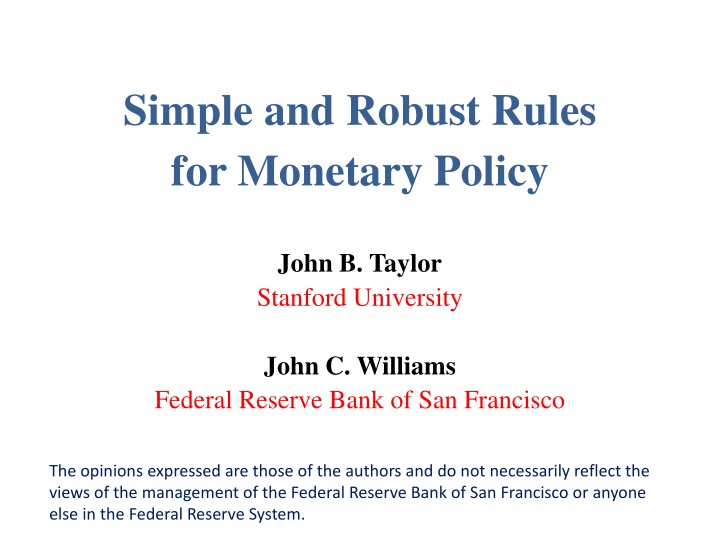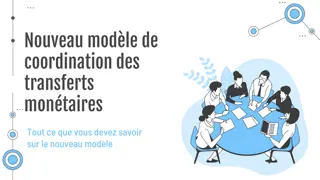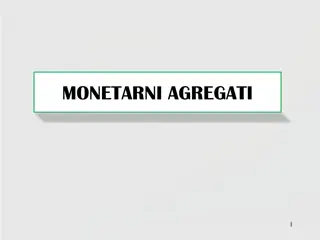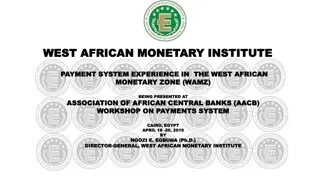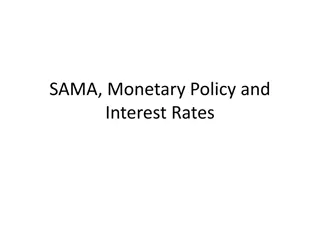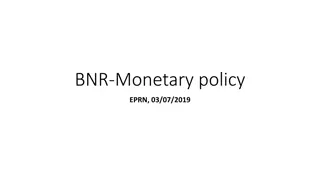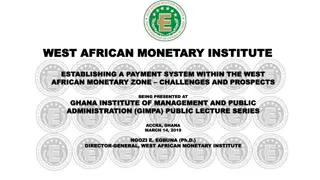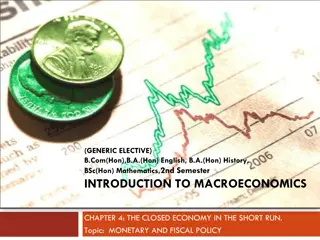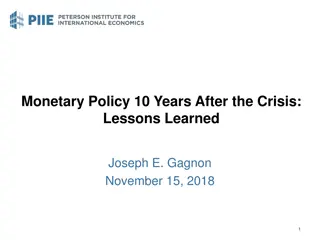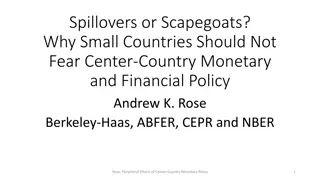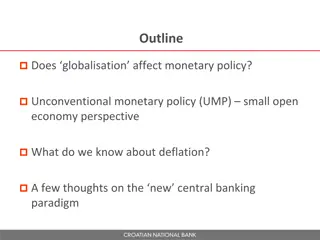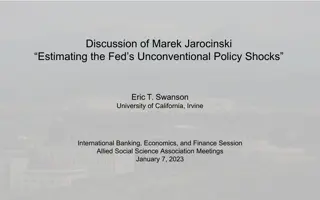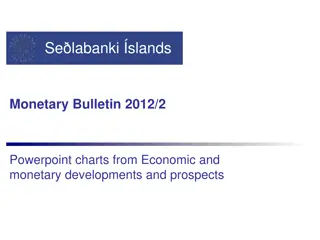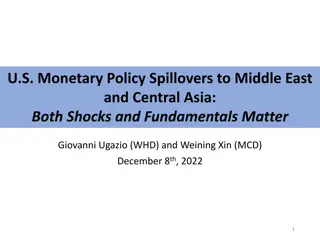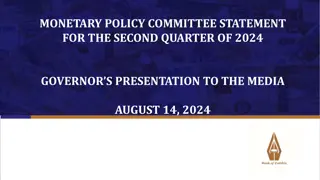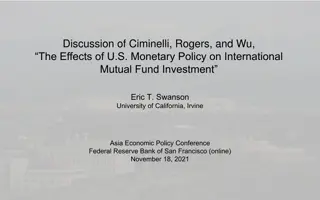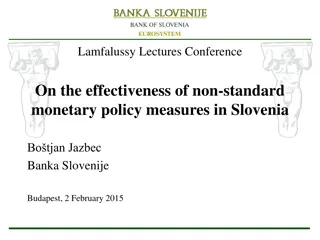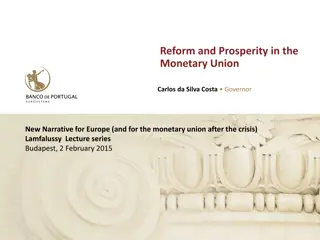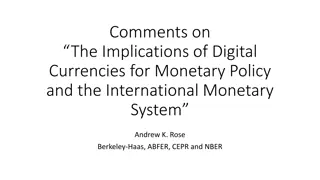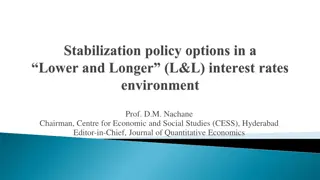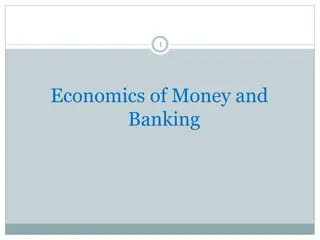Simple and Robust Rules for Monetary Policy Overview
This document discusses the historical background, empirical experience, characteristics of simple rules, robustness, and the comparison between optimal control and simple rules in monetary policy. It explores the evolution of policy rules from Smith and Ricardo to modern approaches, emphasizing the importance of rules-based frameworks in guiding monetary policy decisions. The focus is on understanding the benefits of implementing straightforward and resilient rules to achieve stability and mitigate economic shocks effectively.
Download Presentation

Please find below an Image/Link to download the presentation.
The content on the website is provided AS IS for your information and personal use only. It may not be sold, licensed, or shared on other websites without obtaining consent from the author.If you encounter any issues during the download, it is possible that the publisher has removed the file from their server.
You are allowed to download the files provided on this website for personal or commercial use, subject to the condition that they are used lawfully. All files are the property of their respective owners.
The content on the website is provided AS IS for your information and personal use only. It may not be sold, licensed, or shared on other websites without obtaining consent from the author.
E N D
Presentation Transcript
Simple and Robust Rules for Monetary Policy John B. Taylor Stanford University John C. Williams Federal Reserve Bank of San Francisco The opinions expressed are those of the authors and do not necessarily reflect the views of the management of the Federal Reserve Bank of San Francisco or anyone else in the Federal Reserve System.
Outline Historical background Empirical experience Characteristics of simple rules Robustness Optimal control vs. simple rules
Historical Background Smith, Ricardo, Fisher, Wicksell, Friedman Rules proposed in response to crises and excesses to reduce monetary shocks and mitigate other shocks Rules versus chaotic monetary policy Rules as guideposts for policy Monetary growth targets Policy rules
1980s and 1990s: Finding a Few Good Rules Stochastic simulations of alternative policy rules in different estimated models Instrument choice (interest rate, monetary aggregate, exchange rate) Formal optimization techniques in simple models Evaluation of representative policy rules across models (Bryant-Hooper-Mann) Long list of models 1993: Brookings project (Bryant) 1999: NBER Monetary Policy Rules (Taylor) Today: Model data base (Wieland)
Experience with Great Moderation Many studies showing monetary policy more systematic and responsive during the Great Moderation than before Policy well described by policy rule (Clarida-Gali- Gertler, Judd-Rudebusch, Woodford) Timing suggestive but not definitive (Cecchetti, Stock and Watson) Policy rule presriptions regularly discussed at central banks.
Evaluating Simple and Robust Rules Characteristics of optimal simple rules Robust Policies Simple rules vs. Optimal policies
Central Bank Objective Ad hoc quadratic central bank loss: L = E{ ( - *) 2 + y2 + (i i*) 2} where E denotes the unconditional expectation, is the inflation rate, * is the inflation target, y is the output gap, and i is the nominal short-term interest rate. The central bank loss can also be derived as the second-order approximation to household utility
Simple Policy Rules Simple (three-parameter) rules: it = (1- )( t + r*) + it-1+ ( t - *) + yt : policy inertia parameter This type of rule inherently leans against the wind of deviations of objective variables from target values.
Policy Inertia in RE Models y Level vs. Inertial Rules in FRB/US Model 5 4.5 Inertial Rule 4 Level rule 3.5 3 2.5 2 1.5 1 1.2 1.4 1.6 1.8 2 2.2
Price Level Targeting (PLT) Price-level targeting rules: it = (1- )( t + r*) + it-1+ [ln(pt) ln(pt*)] + yt pt* : price level target (deterministic trend) PLT rules perform very well in a wide variety of forward- looking models, especially with ZLB, gap mismeasurement, learning (Eggertsson & Woodford, Reifschneider and Williams(2000), Orphanides and Williams (2002, 2008). However, effectiveness of PLT depends critically on rational expectations; PLT rules can perform poorly in models with adaptive expectations (Taylor (1999), Levin and Williams (2003), Reifschneider and Roberts 2005, Williams 2006).
PLT vs. IT in RE Models y Policy Frontiers in the FRB/US Model 5 4.5 =0 Policy rule responds to: 4 Price level 3.5 Inflation rate 3 2.5 2 1.5 =1/3 =1 1 =3 0.5 0 1.2 1.4 1.6 1.8 2 2.2
Robust Monetary Policy Rules Robustness: policy performs well across a wide spectrum of models and environments Methodologies: Bayesian, robust control, minimax regret McCallum (1988), Taylor (1993), Levin et al (1999, 2003), Levin and Williams (2003), Orphanides and Williams (2002, 2008); Brock, Durlauf, and West (2003, 2007), Tetlow (2006), Brock, Durlauf, Nason, and Rondina (2007)
Types of Uncertainty Mismeasurement of data and gaps Parameter values Model specification small-, medium-, large-scale closed vs. open economy expectations formation (adaptive, rational, learning) estimation sample
Gap Mismeasurement Optimal Response to Lagged Interest Rate ( ) Optimal Response to Inflation ( ) 1 0.5 0.9 0.8 0.4 0.7 0.6 0.3 0.5 0.4 0.2 0.3 0.2 0.1 0.1 0 0 0 1 Degree of misperceptions 2 3 0 1 2 3 Degree of misperceptions Optimal Response to Change in Unemployment Rate ( ) Optimal Response to Unemployment Gap ( ) 0 0 -1 -0.5 -2 -1 -3 -4 -1.5 -5 -2 -6 0 1 2 3 0 1 Degree of misperceptions 2 3 Degree of misperceptions
Robustness to Model Uncertainty Coefficient on Lagged Interest Rate ( ) Coefficient on Output Gap ( ) % L % L 200 200 Rudebusch- Svensson 150 150 Fuhrer 100 100 Woodford 50 50 0 0 0 0.3 0.6 0.9 1.2 1.5 0 1 2 3
Robustness to Bounded Rationality % L Optimal Coefficient on Unemployment Gap ( ) OptimalCoefficient on Inflation Rate ( ) % L 200 200 Private learning 150 150 100 100 Private learning + natural rate misperceprions Private learning 50 50 Private learning + natural rate misperceptions Perfect knowledge Perfect knowledge 0 0 0 0.5 1 1.5 2 2.5 3 -6 -5 -4 -3 -2 -1 0
Optimal Control Policy Optimal control policy minimizes loss (Woodford 2003, Svensson-Woodford 2003, Giannoni-Woodford 2005) Provides very small stabilization benefits over optimized simple rules. Can be less robust to uncertainty than robust simple rules and be difficult to communicate.
Simple Rules vs. Optimal Control y Simple Rules vs. Optimal Policies in the FRB/US Model Simple three-parameter rules perform nearly as well as the fully optimal policy in wide variety of empirical macro models , including the Fed s large- scale FRB/US model (Levin and Williams 2003, Williams 2003, Orphanides and Williams, 2002, 2008) 5 4.5 Inertial Rule 4 Optimal Control Policy 3.5 3 2.5 2 1.5 1 1.2 1.4 1.6 1.8 2 2.2 Source: Williams, FRBSF Economic Review (2003).
Simple Rules vs. Optimal Control and medium- scale DSGE models (Schmitt-Grohe and Uribe, 2005, Levin- Onatski-Williams- Williams 2005) Source: Levin, Onatski, Williams, Williams, NBER Macro Annual (2005).
Robustness of Optimal Control Policy Robustness to Learning L 18 16 Optimum Control Policy 14 Modified Optimum Control Policy 12 10 Inertial Rule Difference Rule 8 6 0 0.005 0.01 0.015 0.02 0.025 0.03
Counterfactual Simulation of Optimal Control Policy Percent 12 10 Data 8 6 4 2 OC policy ( = 16, = 1) 0 -2 1965 1970 1975 1980 1985 1990 1995 2000 2005
Counterfactual Simulation of Robust Policy Rule Percent Percent Percent Percent Percent 12 10 Data Data Data Data Data 8 6 4 2 Robust policy rule 0 -2 1965 1970 1975 1980 1985 1990 1995 2000 2005
